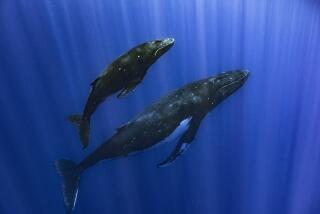Not all killer whales alike, biologists say
- Share via
Killer whales may all look alike, but molecular biology indicates there are at least three distinct species of orca and maybe five or more, researchers reported Thursday in the journal Genome Research.
FOR THE RECORD: The headline on an earlier version of this article said the classification of at least three distinct species of orca was based on the whales’ feeding habits and behavior. Researchers made the new findings based on DNA analysis.
Although all such whales are currently included in a single species, Orcinus orca, biologists had speculated that there were actually more than one, based on behavior, feeding habits and subtle differences in shape and markings. Some killer whales, for example, feed exclusively on seals, and others prefer fish.
But previous attempts to distinguish among them had been “inconclusive” because researchers looked only at a small portion of their DNA — notably segments of DNA in mitochondria, the tiny organelles that serve as the power plants for all cells in the body, said molecular biologist Phillip A. Morin of the National Oceanic and Atmospheric Administration’s Southwest Fisheries Science Center in La Jolla. Those segments were all very similar.
Morin, the primary author of the report, took advantage of new sequencing technologies to study all the DNA in the mitochondria of tissue samples from 139 orca. The team’s results, he said, “clearly show that these different groups are genetically distinct.”
The killer whales that eat fish exclusively are one such distinct species, as are those that eat only seals. A group of “mammal-eating transient killer whales” in the North Pacific are a third species. At least two other groups may also be separate species, but proving it will require further study of nuclear DNA, Morin said.
Differences in the whales’ DNA sequences indicate that the species diverged from common ancestors 150,000 to 700,000 years ago, the study found. “That’s not long in evolutionary time, but it is long enough for them to become distinct species,” Morin said.
He compared the study to ones with bats, most of which — like whales — tend to look alike. Only when researchers performed genetic analyses were they able to distinguish new species.
Morin undertook the project, he said, “to try to understand what is out there, whether they are endangered and how to write conservation plans. You can’t conserve a species if you don’t know what it is.” Concentrating conservation efforts on one group of whales on the assumption that all killer whales are the same species, he said, could easily lead to extinction of one or more of the species.
There is no recognized international group responsible for naming such new species, Morin said. Some researcher will probably compile all the information about each distinct species and then a name will be proposed. “That is a field of its own,” he said. “I might be involved, but I probably won’t be the person pulling it all together.”






